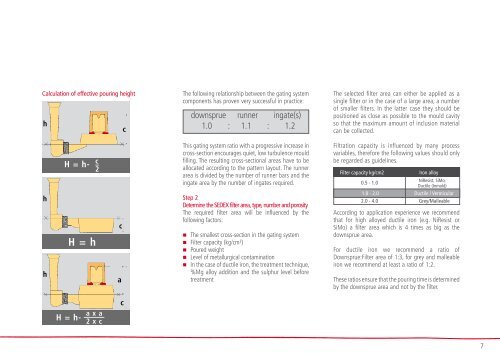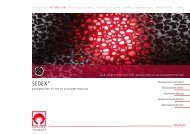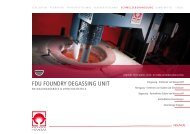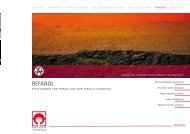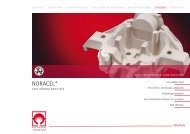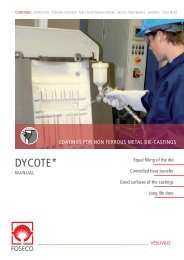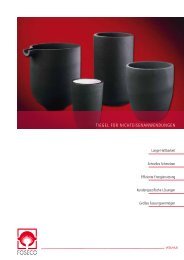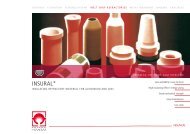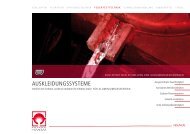SEDEX* - Foseco
SEDEX* - Foseco
SEDEX* - Foseco
- No tags were found...
You also want an ePaper? Increase the reach of your titles
YUMPU automatically turns print PDFs into web optimized ePapers that Google loves.
ht<br />
ting system<br />
practice:<br />
(s)<br />
increase in<br />
lence mould<br />
have to be<br />
, the runner<br />
ars and the<br />
uired.<br />
Calculation of effective pouring height<br />
The following relationship between the gating system<br />
components has proven very successful in practice:<br />
Step 2<br />
Determine the SEDEX filter area, type, number<br />
and porosity. The required filter area will be<br />
influenced by the following factors:<br />
■ The smallest cross-section in the gating system<br />
■ Filter capacity (kg/cm²)<br />
■ Poured weight<br />
This gating system ratio with a progressive increase in<br />
cross-section encourages quiet, low turbulence mould<br />
filling. The resulting cross-sectional areas have to be<br />
allocated according to the pattern layout. The runner<br />
area is divided by the number of runner bars and the<br />
ingate area by the number of ingates required.<br />
■ Level of metallurgical contamination<br />
■ In the case of ductile iron the treatment technique,<br />
%Mg alloy addition and the sulphur level before<br />
treatment<br />
The selected filter area can either be applied as a<br />
single filter or in the case of a large area, a number<br />
of smaller filters. In the latter case they should be<br />
positioned as close as possible to the mould cavity so<br />
that the maximum amount of inclusion material can<br />
be collected.<br />
Filtration capacity is influenced by many process<br />
variables, therefore the above values should only be<br />
regarded as guidelines.<br />
Filter capacity<br />
kg/cm 2<br />
0.5 - 1.0<br />
downsprue runner ingate(s)<br />
1.0 : 1.1 : 1.2<br />
Step 2<br />
Determine the SEDEX filter area, type, number and porosity<br />
The required filter area will be influenced by the<br />
following factors:<br />
• The smallest cross-section in the gating system<br />
Iron Alloy<br />
• Filter capacity (kg/cm²)<br />
NiResist, SiMo, D5<br />
• Poured weight<br />
Ductile (Inmold)<br />
• Level of metallurgical contamination<br />
• In the case of ductile iron, the treatment technique,<br />
%Mg alloy addition and the sulphur level before<br />
treatment<br />
1.0 - 2.0 Ductile<br />
2.0 - 4.0 Grey/Malleable<br />
According to our application experience we<br />
recommend that for high alloyed ductile iron (e.g.<br />
NiResist or SiMo) a filter area which is 4 times as<br />
big as the downsprue area. For ductile iron we<br />
recommend a ratio of Downsprue:Filter area of 1:3,<br />
for grey and malleable iron we recommend at least<br />
a ratio of 1:2. These ratios ensure that the pouring<br />
time is determined by the downsprue area and not<br />
by the filter.<br />
The selected filter area can either be applied as a<br />
single filter or in the case of a large area, a number<br />
of smaller filters. In the latter case they should be<br />
positioned as close as possible to the mould cavity<br />
so that the maximum amount of inclusion material<br />
can be collected.<br />
Filtration capacity is influenced by many process<br />
variables, therefore the following values should only<br />
be regarded as guidelines.<br />
Filter capacity kg/cm2<br />
0.5 - 1.0<br />
Iron alloy<br />
NiResist, SiMo,<br />
Ductile (Inmold)<br />
1.0 - 2.0 Ductile / Vermicular<br />
2.0 - 4.0 Grey/Malleable<br />
According to application experience we recommend<br />
that for high alloyed ductile iron (e.g. NiResist or<br />
SiMo) a filter area which is 4 times as big as the<br />
downsprue area.<br />
For ductile iron we recommend a ratio of<br />
Downsprue:Filter area of 1:3, for grey and malleable<br />
iron we recommend at least a ratio of 1:2.<br />
These ratios ensure that the pouring time is determined<br />
by the downsprue area and not by the filter.<br />
7


